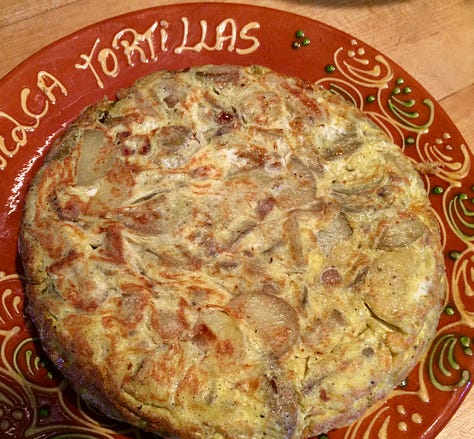


Some years back my sister and I talked about launching a breakfast restaurant just outside of town. It was to be open only for breakfast, and though we, the owner-chefs, would have to get up early (breakfast on the working coast of Maine often begins at 5:30 a.m.), we’d be done serving by noon and could go home for the rest of the day.
Nothing came of it. It was just a daydream. But later, my daughter and I nourished a similar fantasy—a restaurant that served only breakfast, but for longer hours, and breakfast would come from all over the world, wherever life had landed us in the past, wherever we had been introduced to grand ideas of what breakfast might entail. We talked about congee, or jook, that velvety smooth rice porridge from southern China that can be invigorated with so many different flavors from fish sauce to pork to chicken to basic vegetarian ingredients (ginger, soy sauce, tofu, miso, shredded scallions). Scroll down for a recipe at the end. We also talked about breakfasts we’d enjoyed from street stalls in Kerala, especially masala dosas and crisp fried vadas, savory doughnuts made from split lentil dough (urad dal). And we reminisced about the fabled breakfasts in the Middle East: in Beirut on the terrace of the Commodore Hotel I often had breakfast with my favorite taxi driver before setting out on a trip to Damascus or Byblos or down to the sea at Tyre. At the Commodore breakfast consisted of an array of olives, both black and green, fresh spring onions, radishes as large as small apples, accompanied by steamed foul medames beans, fresh green mint and cilantro, mana’ish flatbreads warm from the saç on which they were baked and spread with oily za’atar, and sometimes hummus or baba ghanouj, the whole anchored by thick dollops of strained yogurt labneh with a thick thread of Lebanese olive oil on top. Or, we said, we might serve one of the bean-based soups from North Africa, like the leblebi we had from a stall in the Tunis souq, with its array of garnishes, pickled turnips, chopped scallions, chopped hard boiled eggs, toasted croutons, olive oil of course, and a swirl of fragrant harissa, as pungent as you wish. Or a Spanish tortilla, more often served as a bar snack or tapa rather than for breakfast but still, nonetheless, making excellent morning fare and very different from Mexican tortillas since it is basically a potato and onion omelet or frittata.
Well, you get the picture. We were not thinking breakfast as your standard bacon-and-eggs, although we’d have that on the menu too, along with buckwheat pancakes with maple syrup, and probably for special occasions an old-fashioned Maine apple pie with a hunk of cheddar cheese on the side.
And you probably get, too, that I am a huge fan of breakfast, which I consider the most important meal of the day, no matter on which continent it is consumed. The only place where breakfast is to be ignored as totally lacking in interest is in my own beloved Italy where, all too often, breakfast is taken while standing at the crowded bar and consists of milky, sugary cappuccino with a corneto, the Italian take on French croissants and far inferior to the ultramontane version.
How did the Italians come to treat breakfast with such disrespect? I have a theory: coffee in Italy is as good as it can ever be. Like Italian olive oil, it is pungent, sweet, and aromatic all at once. With coffee like that on the table, Italians feel, little needs to be added beyond a basic carb (that corneto), a hit of sugar, e basta. All else is dross.
But an old-fashioned American breakfast is not to be sneered at. Indeed, there are those of us who feel that breakfast is truly America’s greatest contribution to the world table. Pancakes, griddle cakes, crêpes, waffles, muffins, popovers, all these it’s true are immigrants from some other part of the world, but so are most Americans. Like eggs and bacon (or sausages, or corned beef hash), oatmeal with cream and maple syrup, the smoothies beloved of half-awake teenagers rushing off to school, avocado toast, French toast, peanut-butter-and-jam toast, smoked salmon and a schmear on a crispy bagel, of course granola, even Mr. Kellogg’s corn flakes with berries on top, even a bowl of leftover soup—all qualify for breakfast somewhere, anywhere, in the USA.
Sad news from the home front:
I’ve just learned that my favorite breakfast spot, Marriner’s on Main Street in Camden, Maine, where the corned beef hash is among the very finest in the state if not all of New England, has been sold, rumor has it to a Southerner. Which means we will probably soon see a menu featuring cheesy grits and biscuits with gravy instead of our beloved two eggs with house-made hash. Reader, I weep.
And don’t get me started on doughnuts.
I was taken to a doughnut factory once when I was a kid. It was somewhere up in what Mainers call The County, Aroostook County they mean, in northern Maine, and although they called it a factory, you would probably not call it that today. It was in fact a small doughnut shop where they turned out doughnuts all day long for their customers, some of whom came long distances for these fabled treats. These were what southerners call “cake doughnuts,” which are, to New Englanders, the only doughnuts worth eating. The others are yeast doughnuts and we don’t include them in the doughnut definition. And this was no Krispy Kreme, with its hundreds of glazed, iced, filled, and topped confections. The doughnuts were sober and straightforward, although they came in several varieties, including chocolate and sugar coated, and in season, cider doughnuts with a tang of slightly fermented apple juice. The raw dough circles came tumbling out into a vat of bubbling lard and lined themselves up by instinct, it seemed, in long rows like cows at the milking stall. The fascinating part for a small girl watching hungrily as aromas of nutmeg and cinnamon ascended from the boiling fat, was the way the man in charge flicked down the rows of doughnuts with his long pole, a magic wand in fact, and flipped each doughnut over so the pale upper side disappeared and the roasted, browned, fried side emerged on top. It was a matter of minutes, seconds perhaps, before the doughnuts were scooped out and--hot, greasy, fragrant--dipped in sugar or cinnamon-sugar or left on their own, which was how I liked them, then slipped into waxed paper bags and handed, warm, to waiting customers.
I have never had a doughnut quite so delicious. If I had been a coffee drinker (but I was too young for coffee which might stunt my growth), it would have made a perfect breakfast. As for the doughnut holes, fried separately and offered to waiting children, well, I won’t even go there.
Sorry, the rest of this is for paid subscribers. If you’re not already a paid subscriber, please consider becoming one so you can experience the totality of life on the Kitchen Porch, including archived material and recipes.
Keep reading with a 7-day free trial
Subscribe to On the Kitchen Porch to keep reading this post and get 7 days of free access to the full post archives.






